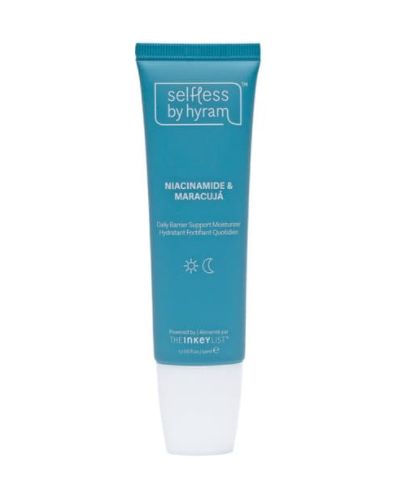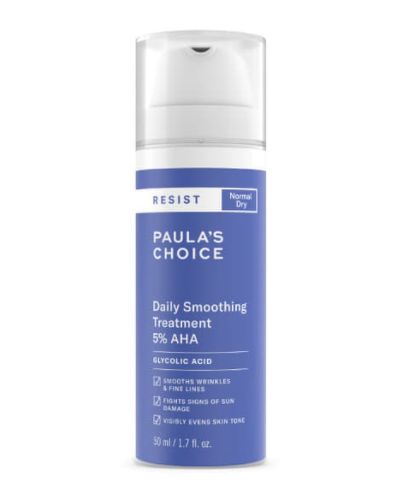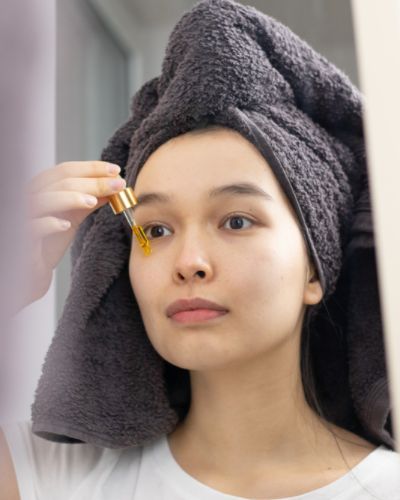You can mix niacinamide with glycolic acid, and this combo can improve multiple skin concerns, including excess oil production, enlarged pores, uneven skin tone, rough and bumpy texture, closed comedones, and even mild to moderate acne.
However, as always, even though these two actives are relatively easy to use and tolerate, you still need to be aware that potential side effects may occur.
Therefore, in this article, we will talk about the benefits and risks of using niacinamide and glycolic acid together as well as how to properly combine them for best results and no unwanted reactions.

How Does Niacinamide Work?

Niacinamide is an effective anti-inflammatory ingredient found in many skincare products, including cleansers, serums, moisturizers, and sunscreens.
This powerhouse ingredient is great for treating blemishes caused by inflammation due to its anti-inflammatory properties and can suppress the skin’s inflammatory response to calm redness, sores, and even rashes.
Niacinamide also encourages the production of ceramides which are an important part of a strong skin barrier and are an essential component when it comes to preventing moisture loss and irritation.
Lastly, niacinamide inhibits melanosome transfer from the pigment-producing cells to skin cells, which means it will stop the uneven deposition of pigment on a cellular level and help brighten hyperpigmentation on the skin’s surface.
Some benefits of using niacinamide include:
- Balanced oil production.
- Normalized skin function.
- Less inflammation and irritation on the skin.
- Hydration and softness.
- Improved acne breakouts.
RELATED: Can You Mix Niacinamide with Retinol?
How Does Glycolic Acid Work?

Glycolic acid is a substance that belongs to the family of alpha-hydroxy acids (AHAs), and it is a naturally occurring substance that can be found in sugar cane, sugar beets, pineapple, papaya, tomatoes, cantaloupe, and unripe grapes.
However, the glycolic acid used in skincare products is synthetically made in a lab due to being more stable and safer overall.
Glycolic acid is the strongest and most potent member of the family of AHAs, and this is due to having the smallest molecular weight, which allows it to penetrate the skin easier and work faster.
Glycolic acid is also a water-soluble substance, which means that it has the ability to work on the surface layer of the skin; however, it cannot cut through the oil and penetrate deeper than that, so it is most useful for superficial exfoliation.
Superficial exfoliation can be super beneficial for targeting various skin concerns, including superficial lines and wrinkles, hyperpigmentation, uneven skin tone, and rough, bumpy texture.
But although salicylic acid is the chief anti-acne ingredient when it comes to exfoliating acids, glycolic acid can also be good for acne-prone skin.
This is because glycolic acid also has antibacterial properties, but regular exfoliation prevents excess dead skin cells from clogging up the pores and contributing to acne.
Some benefits of using glycolic acid are:
- Brighter complexion.
- Smoother skin texture.
- Improved scarring.
- Improved hyperpigmentation.
- Improved appearance of fine lines and wrinkles.
- Evened out skin tone.
- Decreased acne.
- Hydrated and healthy skin.
RELATED: The Complete Guide to Using Glycolic Acid.
Benefits of Mixing Niacinamide with Glycolic Acid
A research study that subjected 52 volunteers to an anti-aging skincare routine containing alpha-hydroxy acids and vitamins B3 (niacinamide), C, and E saw significant improvement in wrinkles and fine lines with an improved skin texture without adverse effects.
When using them together, niacinamide will be the ingredient that’ll balance out oil production, refine enlarged pores, strengthen the skin barrier, and improve mild pigmentary irregularities.
At the same time, glycolic acid will take care of surface irregularities such as closed comedones which happen when there’s sebum trapped underneath the skin, as well as rough and bumpy texture and mild to moderate hyperpigmentation.
But besides that, glycolic acid will also improve the appearance of fine lines and wrinkles, especially in areas where the skin is thinner such as the forehead.
After a certain time of being consistent with using niacinamide and glycolic acid, you should expect to see brightened and evened-out skin tone, smoother texture, decreased hyperpigmentation, improved lines, and wrinkles, and a healthier, more uniform complexion.
RELATED: Best High-End Products for Aging Skin.
How to Use Niacinamide with Glycolic Acid?

Both niacinamide and glycolic acid can be used in water-based formulations, including serums and moisturizers. Both ingredients are very compatible to be used together.
However, if you have never used neither active before, the best thing to do is opt for a milder concentration of both.
For example, a 5% niacinamide and anything between 5-8% glycolic acid will be a good start before you can gradually work your way up as your skin builds tolerance.
Although both ingredients are safe, glycolic acid has a little bit of a reputation to cause skin irritations and sensitivity; therefore, you shouldn’t exclude the possibility of irritation that can occur by mixing niacinamide with glycolic acid.
The next best thing to do, alongside using low concentration products, is to use them in the evenings with a day or two break in between.
As for the order of using them, you should always use exfoliating products right after cleansing on clean skin and leave them to act for anywhere between 2-5 minutes.
Once the exfoliating solution is fully dried, you should then dampen your skin by spraying a little bit of thermal water and apply a small, pea-sized amount of niacinamide on damp (not wet) skin.
You can also use low concentration glycolic acid such as the Paula’s Choice Daily Smoothing Treatment with 5% AHA after cleansing and follow it up with a moisturizer that contains niacinamide, such as EltaMD PM Therapy Facial Moisturizer or CeraVe PM Oil-Free Moisturizer.
This way, you will be getting the best of both worlds while also nourishing and hydrating your skin instead of bombarding it with potent actives.
Risks of Mixing Niacinamide With Glycolic Acid
As with any other active ingredient, the risk of potential irritation is present when mixing niacinamide with glycolic acid.
Using exfoliators too frequently can definitely lead to over-exfoliated skin, which usually shows signs of irritation by becoming red, itchy, painful, and irritated when applying certain products or even when washing your face with plain water.
Besides that, since AHAs like glycolic acid work on the surface of the skin, they lead to an increase in sensitivity to UV rays, which means you should be diligent with your sunscreen application when starting to use alpha-hydroxy acids in your routine.
If you are using AHAs but not applying sunscreen or you sweat a lot during the day, and the sunscreen wears off faster than it usually would, bear in mind that you may start to experience symptoms of a chemical burn, such as red or dark uneven patches on the nose, cheeks, and forehead.
This means that you should use a high protection factor of 30+ and reapply it every two hours or even more frequently if you sweat a lot.
You should also consider alternatives such as setting your sunscreen with powder sunscreen on top to prevent it from rubbing off due to sweating. Here is an article with the best powder sunscreens with high SPF suitable for summer.
Lastly, overusing these two actives can also lead to dryness, so if you start noticing unusual dryness and peeling, it’s best to minimize use or use them sparingly.
Don’t forget to always listen to your skin and give it what it needs, not what you want.
Many people try to treat issues such as hyperpigmentation or uneven skin tone and end up wrecking their barrier in the process just because they don’t want to be patient with their skin.
Bombarding your skin with potent actives won’t give you faster and better results. It will only set you up for failure and probably give you irritations and a lot of discomforts.
RELATED: Best Products to Instantly Soothe Irritated Skin.

My name is Simone and I am a certified skin specialist. I created this website to teach my readers how to take great care of their skin and I also like to occasionally share my honest opinions on skincare products I’ve tried. You can learn more about me here.

I’ve had issues in the past with mixing ingredients, including peeling and redness. It’s good to know that these two can be mixed. As advised, I’ll start off with a low concentration and work up from there. Thank you 🙂